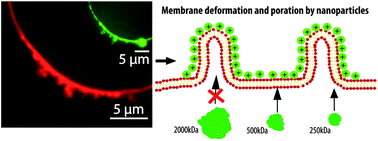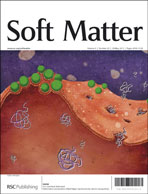Deformation and poration of lipid bilayer membranes by cationic nanoparticles†
Abstract
Synthetic lipid bilayers in a giant unilamellar vesicle (GUV) format were used to study potentially harmful interactions between nanoparticles and biomembranes. Confocal fluorescence microscopy shows that 20 nm polystyrene nanoparticles with cationic surfaces adhere strongly to these lipid bilayer membranes. This adhesion is sensitive to the ionic strength of the surrounding medium and is independent of the lipid composition of the membrane, indicating that it is driven by nonspecific electrostatic interactions. Nanoparticles bound to the GUV membrane form extended protrusions that incorporate the membrane lipids. As the membrane material is pulled into these protrusions, the diameter of the GUV shrinks. This process is accompanied by the formation of transient pores in the membrane, as indicated by the leakage of high-molecular weight polymers from the GUV interior. There is an upper limit to the molecular weight of polymer that will leak through these pores; based on this size limit, the pore diameter can be estimated as 18–27 nm. These results suggest that nanoparticle adhesion imposes surface tension on biomembranes via a steric crowding mechanism, leading to poration. The phenomenon is potentially a physiologically relevant mode of interaction between nanoparticles and biomembranes, and may help explain observed plasma membrane permeabilization in the presence of broad classes of nanoparticles.

- This article is part of the themed collection: Interaction of nano-objects with lipid membranes

 Please wait while we load your content...
Please wait while we load your content...